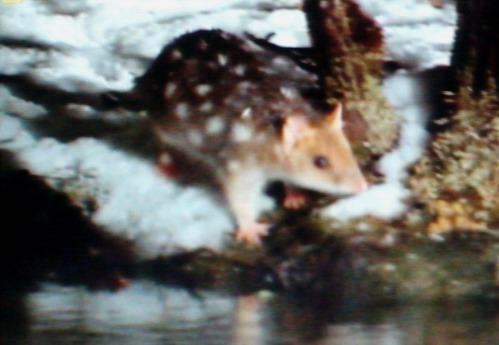Eastern Quoll (Dasyurus viverrinus) {!--동부주머니고양이(호주)--> Captured with my camera from a documentary film.
Eastern Quoll
(Text from http://www.dpiwe.tas.gov.au/inter.nsf/WebPages/BHAN-5373YJ?open)
Description
Male eastern quolls (Dasyurus viverrinus) are about the size of a small domestic cat averaging 60 cm in length and 1.3 kg in weight; females are slightly smaller. They have soft fur that is coloured fawn, brown or black. Small white spots cover the body except for the bushy tail which may have a white tip. Compared to the related spotted-tail quoll, the eastern quoll is slightly built with a pointed muzzle.
Distribution and habitat
Eastern quolls once occured on mainland Australia, with the last sighting occuring in the Sydney suburb of Vaucluse in the early 1960s. They are now considered extinct on the mainland, although some recent sightings in the New England region of northern New South Wales suggest that the species may still survive.
The species, fortunately, is widespread and locally common in Tasmania. It is found in a variety of habitats including rainforest, heathland, alpine areas and scrub. However, it seems to prefer dry grassland and forest mosaics which are bounded by agricultural land, particularly where pasture grubs are common.
Behaviour and diet
The eastern quoll is largely solitary. It hunts and scavenges, feeding largely on insects.
Eastern quolls are nocturnal and only occasionally forage or bask during daylight. During the day they sleep in nests made under rocks in underground burrows or fallen logs.
Like the spotted-tail quoll, the eastern quoll is an opportunistic carnivore that takes live prey and scavenges. The eastern quoll is an impressive hunter, taking small mammals such as rabbits, mice and rats. Eastern quolls sometimes scavenge morsels of food from around feeding devils. However, the main commponent of its diet is invertebrates, especially agricultural pests such as the cockchafer beetle and corbie grub. Carrion and some fruits are also eaten.
Breeding occurs in early winter. After a gestation period of 21 days, females can have up to 6 young that develop in her pouch. After about 10 weeks the young are left in grass-lined dens located in burrows or hollow logs leaving the female free to hunt and forage.
Towards the end of November, when the young are 18 to 20 weeks old, they are weaned (stop suckling) and gradually become independent of the female. Within the first year they have reached sexual maturity and begin breeding.
Feral cats are well suited to taking a quoll and also the prey that quolls eat. Predation and direct competition potentially force the eastern quoll from its natural habitat. The threat from foxes, dogs, roadkills, landowners, and illegal poisoning or trapping are also causing declines. The species is wholly protected by law.
